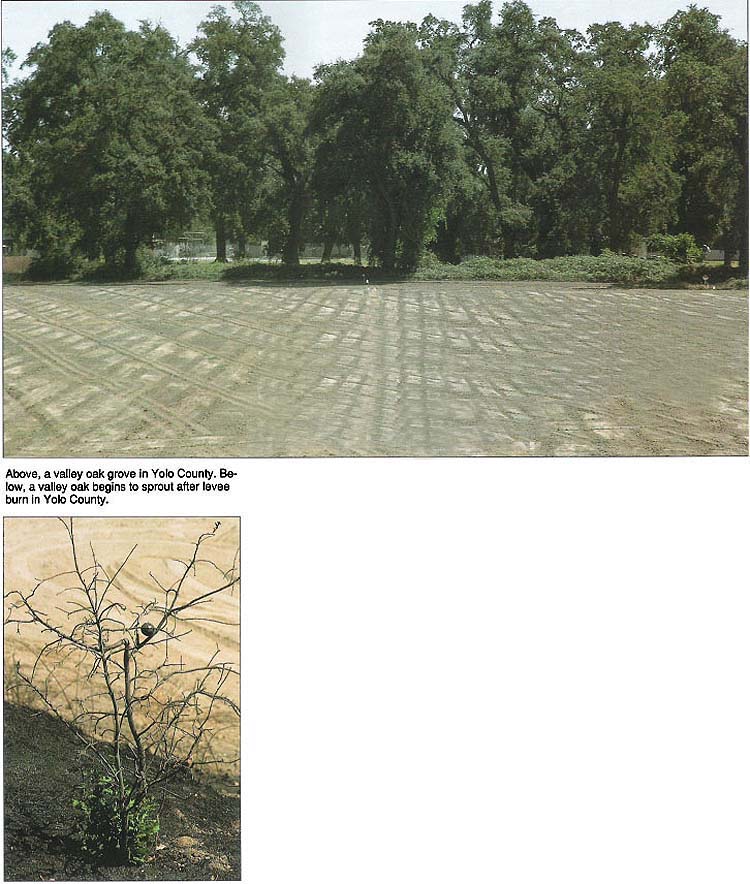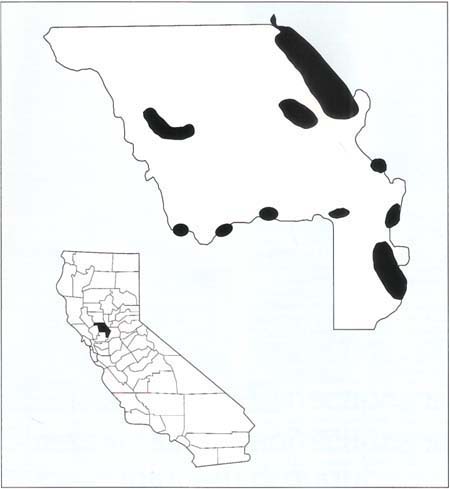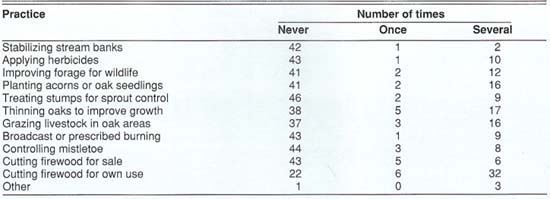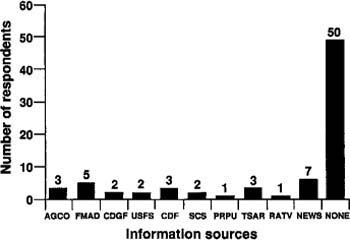All Issues
Strategies needed for oak protection: Despite landowner favor, oak groves likely to diminish in size and number
Publication Information
California Agriculture 45(6):16-18.
Published November 01, 1991
PDF | Citation | Permissions
Abstract
A survey of landowners in unincorporated parts of Yolo County indicates that they perceive many advantages and few drawbacks to oak-grove ownership. Valley oak acreage is used for farming, wildlife habitat, livestock grazing, houses and outbuildings, and firewood production. However, without new strategies to protect and replace them, existing groves will most likely decrease in size and distribution as properties turn over and new owners and management concerns take over.
Full text
Above, a valley oak grove in Yolo County. Below, a valley oak begins to sprout after levee burn in Yolo County.
In 1986, the Yolo County Board of Supervisors received the Historic Resources Survey Report from the county's Historical Advisory Committee. This report was to aid the Board of Supervisors in enacting a Historical Ordinance and a Historical Element in the county's General Plan.
In addition to historic bridges, homes and other structures, the Historical Advisory Committee recognized and listed valley oak groves as having “historic and aesthetic significance.” According to the report, prepared by Kathleen Les with assistance from Howard Moore, European settlers developed agriculture on lands dominated by valley oaks because of the rich, loamy soils at these sites, the availability of acorns for livestock, and the production of fuel (as wood or charcoal) for domestic, industrial and river steamboat use.
Today, valley oak groves are fragmented and their total acreage is greatly reduced. The stands that remain are scattered throughout Yolo County, commonly along major stream and river drainages and on rangelands. Concern about long-term persistence of valley oaks has focused on both the reduction in acreage, and the poor likelihood of stand replacement through natural regeneration processes.
Unlike bridges and buildings, oak trees are living organisms that grow and inevitably die. Although their historical significance was recognized by the Historical Advisory Committee, mere preservation does not ensure their continued presence in the landscape. According to the Wildlife Habitat Relationships System database, developed by members of the California Interagency Wildlife Task Group, over 100 spedes of amphibians, birds, mammals, and reptiles use valley oak groves in Yolo County for reproductive sites, cover or food. For some of these species, their continued presence in the landscape is dependent upon the long-term persistence of valley oak groves.
Because of the potential controversy involved in regulating management of valley oak groves in Yolo County, the Historical Advisory Committee agreed to assist with a survey of valley oak grove owners. The survey, prepared as part of the University of California's Integrated Hardwood Range Management Program, was designed to collect information on the attitudes of Yolo County landowners who own parcels containing at least one valley oak grove, and to assess their knowledge and concerns about valley oak regeneration, mortality and conservation.
Methods
Howard Moore and Ray Fisher, volunteers for the Historical Advisory Committee, mapped the location of valley oak groves in unincorporated areas of the county (fig. 1). For standardization, a valley oak grove was defined as a minimum of five valley oaks forming a group. Using records from the county assessor's office, they identified 254 parcels and, after combining multiple parcels owned by a single owner and eliminating publicly owned parcels, refined the list to 164 parcel owners.
The survey was mailed in February 1989. A follow-up survey was mailed to nonrespondents one month later. Eighty-four usable surveys were returned (51%) and are included in this analysis. Please note that the returned surveys do not constitute merely a percentage of a sample of the target population, but rather a percentage of the population itself.
Attitudes of oak grove owners
Of respondents, 74% reported they were “moderately” to “very” interested in oak issues; 48% said they would like to see more oak trees in the surrounding area, 35% felt there were just the right number, 4% desired fewer trees, and 13% were not sure. However, 75% of the landowners returning the survey were happy with the number of valley oaks on their property, with two-thirds of the remaining landowners wanting more.
When asked about oak values, at least 50% of the respondents indicated that values included providing shade for people, increasing the value of the property, reducing soil erosion, improving wildlife habitat, improving the beauty of the property, providing a source of firewood and having historical significance. The value receiving the most positive comments was improving the beauty of the property (83%). (See article on value of oaks in California Agriculture, September-October 1987). No respondents indicated the oaks had no value.
Landowners were also asked about drawbacks of oak trees. In their only majority response, 62% said there weren't any important drawbacks of oaks. However, 27% noted that oaks decreased the amount of land available for agriculture, and 14% commented that these trees could cause safety hazards to humans (presumably from falling trees or limbs). None of the respondents felt that oak trees decreased the value of the property, increased soil erosion, harmed wildlife habitat, or detracted from the beauty of the property.
Landowners reported that they had an average of 390 acres of valley oaks on their property (n = 46, s.e.= 221). These estimates ranged from 0.01 to 8,000 acres, and totalled 18,000 acres; the larger estimates almost certainly included large open spaces between scattered oak groves. One respondent indicated that valley oaks occurred on 1.5 miles of slough frontage. If the five respondents who reported valley oak acreages larger than 200 acres are eliminated, the mean acreage of valley oak groves becomes 11.2 acres (n = 41, s.e. = 2.4), with a 95% confidence interval about the mean falling between 6.2 and 16.1 acres.
Valley oak acreage was used chiefly for farming, wildlife habitat, livestock grazing, houses and outbuildings, and for firewood production. Landowners were asked which land management practices they had conducted on their groves in the past 5 years. Table 1 shows the variety and frequency of these practices during that period. Firewood cutting was the most often cited use. Evidently, most valley oak stands were being managed passively because most respondents indicated that, except for firewood cutting, they had not used any of the listed management practices during the preceding 5 years.
Valley oaks were producing seedlings according to 75% of respondents. However, 44% of the landowners felt that oaks in the area were having trouble surviving (35% said no, 21% were not sure). Among those who felt oaks were having trouble surviving, the most common explanations were insects and diseases, landscaping practices, lack of water in the summer, and the burning of levees. Wildlife browsing, livestock grazing, and mowing were not considered major sources of mortality. The survey results did not establish whether land development was a serious concern.
Most respondents (68%) lived on their valley oak properties; 58% of groves had been owned for more than 20 years and 23% from 10 to 19 years. In the last 3 years, only two valley oak groves had been sold. However, seven respondents (8%) indicated plans to sell some of their valley oak groves within the next 10 years and seven respondents (8%) planned to cut a valley oak grove within the next 10 years. Eleven respondents (13%) said they intended to plant a new valley oak grove.
When asked why they owned their property with valley oaks, the main reasons given were a preference for the country life rather than the city life (36%), that the property was a nice permanent place to live (27%) and that it was the main source of their livelihood or income (25%). These responses probably reflect an aggregate of land characteristics, not just the valley oaks. Of respondents, 56% indicated that their age was 60 years or older, and only 14% of respondents were less than 39 years of age. Most (60%) had not received any information from any source about oak trees in the preceding year. Newspapers were listed as a source for 8% of respondents, the UC Cooperative Extension's Yolo County office for 6%, and the remaining respondents reported a variety of state and federal agencies as information sources (fig 2).
Discussion and conclusions
On April 19, 1990, the Yolo County Board of Supervisors adopted a resolution declaring 1990 to be the “Year of the Oak” and authorized staff to begin drafting an oak tree preservation ordinance. An aggressive, voluntary oak protection and enhancement program could be an effective alternative to the regulatory approach. Owners of valley oak groves in Yolo County indicated a high level of interest in oaks, pointing out a number of values of these trees and few drawbacks.
The number of valley oak groves in the county will probably remain stable as long as the properties are maintained and managed by the current owners and operators. Taking into account present cutting and selling frequency (at least 8% of respondents cutting or selling groves in the next 10 years), the age distribution of current owners (56% greater than 60 years of age), the slow attrition of individual trees for firewood (the predominant management practice) and the regeneration potential of existing groves (low), present groves will most likely decrease slowly and steadily in size and distribution as properties turn over and new owners and managers take over. An effective and realistic oak management policy is needed.
From the perspective of oaks as historical monuments, a strategy needs to be developed that will encourage landowners and land users to plant new groves to maintain the presence of these trees in the future landscape. Plantings should be encouraged in areas where the valley oaks will not come into conflict with agricultural or safety concerns. An alternative to planting is the protection and enhancement of naturally occurring seedlings by protecting them from grazing animals, providing weed control, and utilizing selective mowing. Efforts should focus on producing sustainable groves or populations of valley oaks and associated wildlife and plants.
Fig. 2. Sources of information on oak trees reported by respondents of survey. The key to the information sources is as follows: AGCO = County Agricultural Commissioner's Office, FMAD = U. C. Farm Advisor's Office, CDFG = California Department of Fish and Game, USFS = U.S. Forest Service, CDF = California Dept. Forestry and Fire Protection, SCS = Soil Conservation Service, PRPU = Private or Public Professional, TSAR = Tree Service Company or Arborist, RATV = Radio and television, NEWS = Newspapers, NONE = None of the listed sources.
Using $66,000 in funds from Proposition 70, the 1988 Park Bond Act, Yolo County recently purchased 10.78 acres of mature valley oak woodland north of West Sacramento as a future park development. Acquisitions, coupled with voluntary conservation easements and landowner oak planting and protection programs, will be more important as total acreage of valley oak woodlands decreases in the future.
Landowners could benefit from information being developed by UC's Integrated Hardwood Range Management Program and other sources. Much of this information is designed to enable landowners and managers to integrate oak protection and restoration plans with legitimate land management practices such as grazing, firewood cutting and wildlife management. However, this survey indicates that improved communication links need to be established to direct oak-related information to landowners.
Because of the variety of educational material on oak management currently available and because the majority of valley oak grove owners are either moderately or very interested in oak issues, effective communication links need to be aggressively developed. Communication among all oak-related interest groups, in addition to the landowners, should be encouraged. In the meantime, research is continuing to refine methods for planting and protecting these noble sentinels of the Sacramento Valley. (For previous reports, see January-February 1989 and March-April 1990 issues of California Agriculture.)








